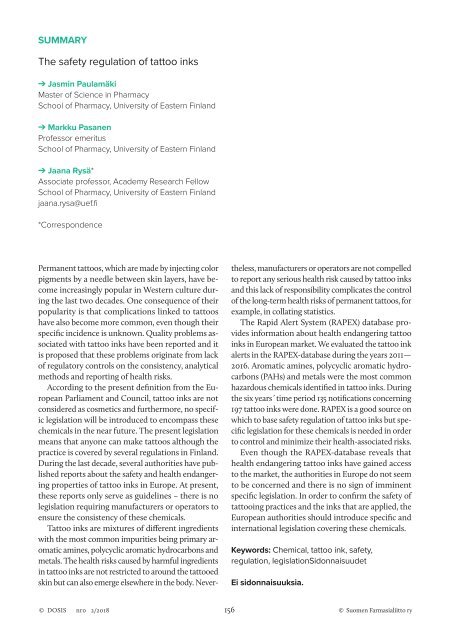DOSIS 2/2018
Farmaseuttinen aikakauskirja DOSIS 2/2018 vol.43 Suomen Farmasialiitto ry
Farmaseuttinen aikakauskirja DOSIS 2/2018 vol.43 Suomen Farmasialiitto ry
You also want an ePaper? Increase the reach of your titles
YUMPU automatically turns print PDFs into web optimized ePapers that Google loves.
SUMMARY<br />
The safety regulation of tattoo inks<br />
➔ Jasmin Paulamäki<br />
Master of Science in Pharmacy<br />
School of Pharmacy, University of Eastern Finland<br />
➔ Markku Pasanen<br />
Professor emeritus<br />
School of Pharmacy, University of Eastern Finland<br />
➔ Jaana Rysä*<br />
Associate professor, Academy Research Fellow<br />
School of Pharmacy, University of Eastern Finland<br />
jaana.rysa@uef.fi<br />
*Correspondence<br />
Permanent tattoos, which are made by injecting color<br />
pigments by a needle between skin layers, have become<br />
increasingly popular in Western culture during<br />
the last two decades. One consequence of their<br />
popularity is that complications linked to tattoos<br />
have also become more common, even though their<br />
specific incidence is unknown. Quality problems associated<br />
with tattoo inks have been reported and it<br />
is proposed that these problems originate from lack<br />
of regulatory controls on the consistency, analytical<br />
methods and reporting of health risks.<br />
According to the present definition from the European<br />
Parliament and Council, tattoo inks are not<br />
considered as cosmetics and furthermore, no specific<br />
legislation will be introduced to encompass these<br />
chemicals in the near future. The present legislation<br />
means that anyone can make tattoos although the<br />
practice is covered by several regulations in Finland.<br />
During the last decade, several authorities have published<br />
reports about the safety and health endangering<br />
properties of tattoo inks in Europe. At present,<br />
these reports only serve as guidelines – there is no<br />
legislation requiring manufacturers or operators to<br />
ensure the consistency of these chemicals.<br />
Tattoo inks are mixtures of different ingredients<br />
with the most common impurities being primary aromatic<br />
amines, polycyclic aromatic hydrocarbons and<br />
metals. The health risks caused by harmful ingredients<br />
in tattoo inks are not restricted to around the tattooed<br />
skin but can also emerge elsewhere in the body. Nevertheless,<br />
manufacturers or operators are not compelled<br />
to report any serious health risk caused by tattoo inks<br />
and this lack of responsibility complicates the control<br />
of the long-term health risks of permanent tattoos, for<br />
example, in collating statistics.<br />
The Rapid Alert System (RAPEX) database provides<br />
information about health endangering tattoo<br />
inks in European market. We evaluated the tattoo ink<br />
alerts in the RAPEX-database during the years 2011—<br />
2016. Aromatic amines, polycyclic aromatic hydrocarbons<br />
(PAHs) and metals were the most common<br />
hazardous chemicals identified in tattoo inks. During<br />
the six years´time period 135 notifications concerning<br />
197 tattoo inks were done. RAPEX is a good source on<br />
which to base safety regulation of tattoo inks but specific<br />
legislation for these chemicals is needed in order<br />
to control and minimize their health-associated risks.<br />
Even though the RAPEX-database reveals that<br />
health endangering tattoo inks have gained access<br />
to the market, the authorities in Europe do not seem<br />
to be concerned and there is no sign of imminent<br />
specific legislation. In order to confirm the safety of<br />
tattooing practices and the inks that are applied, the<br />
European authorities should introduce specific and<br />
international legislation covering these chemicals.<br />
Keywords: Chemical, tattoo ink, safety,<br />
regulation, legislationSidonnaisuudet<br />
Ei sidonnaisuuksia.<br />
© <strong>DOSIS</strong> nr0 2/<strong>2018</strong> 156<br />
© Suomen Farmasialiitto ry

















